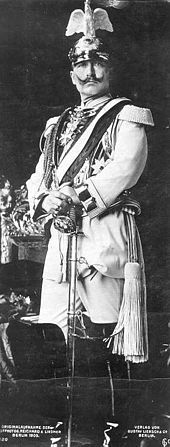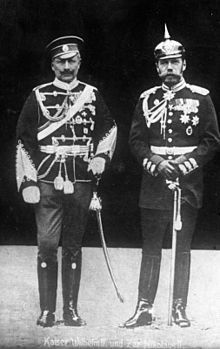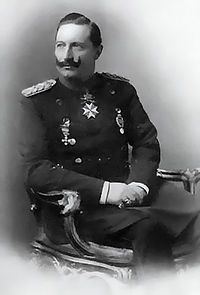The brachial plexus is a group of nerves which supplies the arm and hand. They run from the spinal cord and through the neck into the arm. As a result they are unfortunately susceptible to trauma during the birth process. Particularly this can occur during an obstetric emergency where a baby's head becomes trapped during birth, either from the shoulders being wedged under the mother's pubic bone or an obstructed breech (feet first) birth. The subsequent mechanical manipulation required to free the baby is the usual cause. However when certain death is the alternative - sometimes a brachial plexus palsy is the lesser of two traumas.
Unfortunately, Kaiser Wilhelm did not see it this way.
Wilhelm II of Germany was the son of the son of Prince Frederik William of Prussia and Princess Royal Victoria of the United Kingdom. As such he went on to inherit the titles of Emperor of Germany and King of Prussia. He inherited these titles on the 15th June 1888 and held them until his abdication on the 9th of November 1918.
Kaiser Wilhelm was a militaristic leader who's views were firmly anti-democracy. He was also known to be a somewhat reckless, tempetous and changeable leader with a tendancy to ignore all advice. He tactlessness seriously affected German foreign policy. It was these personality traits that played no small part in the onset of the Great War. Several rash and rapid decisions were made with regards to pressure on Austria to attack Serbia and the mobilisation of the German army which made War inevitable. Although it can, and should, be argued that the causes of WWI were multifaceted, Were the Kaiser of a more levelheaded mindset it is entirely possible that the course of history would have been vastly different.
It is possible to trace this reckless personality to the day of his birth.
On January 29 1859 the then 19 year old Princess Victoria went into labour with her first baby. Her physician, Professor of Obstetrics Eduard Martin was called at 10am, he found her to be 4cm dilated with ruptured membranes and a foetus in the breech position. Using chloroform for pain, Victoria progressed to full dilatation at 1pm and by 2pm the buttocks were visible.
This is when things went wrong. According to Prof. Martin's account after the buttocks emerged no further progress was made and he could feel the pulse in the umbilical cord slowing and "even become intermittant." Subsequently he administer deeper anaesthesia using chloroform to Victoria and then performed the Smellie manouver (a variant of which is still in use today.) Essentially he took the left arm, which was wedged up beside the head and pulled it forward across the body of the prince. By his own account this "involved considerable effort". He then rotated the body to release the right arm, and then delivered the head. At birth the Prince appeared lifeless but was (obviously) quickly resuscitated.
All of this, from noticing there was a concern, administering anaesthesia and finally freeing an entrapped breech would have taken several minutes. The longer a baby remains trapped in the birth canal with the cord compressed (as occurs with breech dystocias) the higher the incidence of brain damage.
As a result of this traumatic birth Kaiser Wilhelm would carry an obvious deformity for the rest of his life. Because of the "considerable effort" required to free his left arm he suffered a brachial palsy injury. His left hand and arm were essentially useless. Due to the muscle wasting his left arm was about 15cm shorter than his right. For the rest of his life Wilhelm would employ several tactics to try and hide this deformity with varying degrees of success. (Several examples can be seen in the photos on this post, look closely).
(Here the Kaiser (on the left) is pictured with Nicholas II of Russia. Although he has attempted to disguise it by holding his sword - the left arm is clearly shorter than the right)
There is some speculation that this deformity and the compensation for it was the driving force behind Wilhelm's personality traits. Wilhelm was known to have a very strained relationship with his mother who he blamed for his injuries, in particular because she had only allowed British physicians to attend her during labour. He has been quoted as saying "“an English doctor killed my father, and an English doctor crippled my arm – which is the fault of my mother."
There is another theory about Wilhelm's difficult personality that potentially relates to the amount of time that passed between the birth of his body and his head. As mentioned earlier the longer the time it takes for this to occur the higher the risk of brain damage. We know from the account of Prof. Martin that even as Wilhelm's body had been born the umbilical cord was already being compressed, meaning a critical lack of oxygen was reaching his brain. He was then born lifeless and required resuscitation, all of which again implies that the baby was in a bad way.
It is not inconceivable to expect that some brain damage may have occurred - perhaps causing the impulsivity and recklessness that characterised Wilhelm throughout his life.
In the end, like all things, it is probably a combination of factors.
But it is amusing to think that an obstetrician may have caused World War I.
References/Bibliography
Alfonso (2011) 'Causes of neonatal brachial plexus palsy' Bulletin of the NYU hospital for joint diseases, vol. 69, 11-16
Jain, Sebire and Talbet (2005) 'Kaiser Wilhelm syndrome: obstetric trama or placental insult in historical case mimicing Erb's palsy' Medical Hypotheses, vol. 65, 185-191
Ober, William (1992), 'Obstetrical Events that Shaped Western European History' The Yale Journal of Biology and Medicine vol. 65, 201-210
http://en.wikipedia.org/wiki/Wilhelm_II,_German_Emperor
http://www.angelfire.com/tv/jarbury/essay/wilhelm.html




An excellent article. It's probably better OBs can't see the future.
ReplyDeleteI've just discovered your blog and have enjoyed your posts very much since I'm also a history nerd.
Now I must go back to work because I have a grant coming due!
Keep it up!
I'm glad you enjoy and good luck with the grant application!
DeleteThis comment has been removed by the author.
ReplyDeleteA small correction - Wilhelm II was the son of Frederick Wilhelm (Kaiser Frederick III), not a "son of a son" of him. His grandparents were K und K Wilhelm I and Prince Albert, consort of Queen Victoria. Love the site.
ReplyDeleteI had to make a typo correction.
Thank you for the correction. I get so focused on the medicine sometimes I stuff the historical details. Apologises :).
Delete